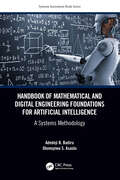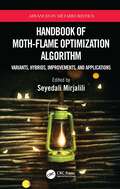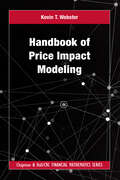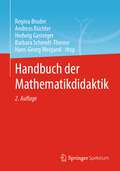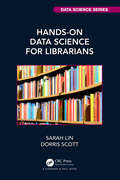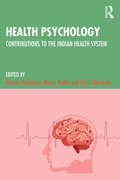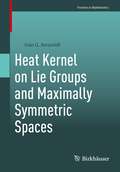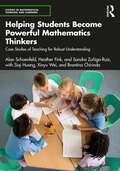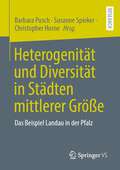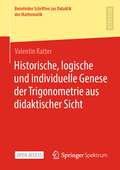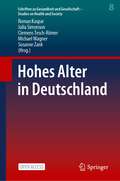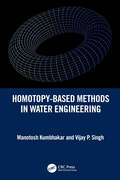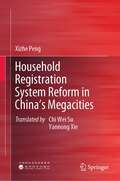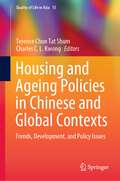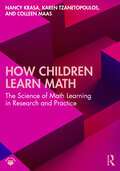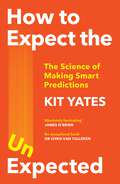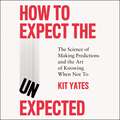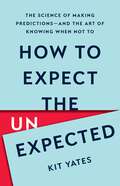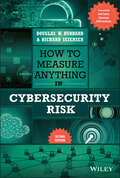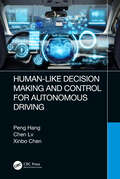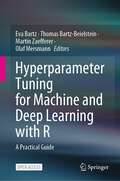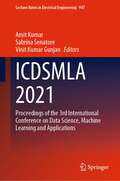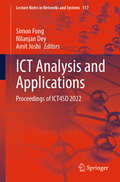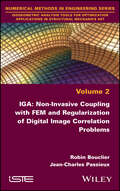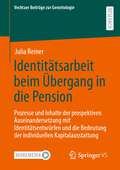- Table View
- List View
Handbook of Mathematical and Digital Engineering Foundations for Artificial Intelligence: A Systems Methodology (Systems Innovation Book Series)
by Adedeji B. Badiru Olumuyiwa AsaoluArtificial intelligence (AI) and digital engineering have become prevalent in business, industry, government, and academia. However, the workforce still has a lot to learn on how to leverage them. This handbook presents the preparatory and operational foundations for the efficacy, applicability, risk, and how to take advantage of these tools and techniques. Handbook of Mathematical and Digital Engineering Foundations for Artificial Intelligence: A Systems Methodology provides a guide for using digital engineering platforms for advancing AI applications. The book discusses an interface of education and research in the pursuit of AI developments and highlights the facilitation of advanced education through AI and digital engineering systems. It presents an integration of soft and hard skills in developing and using AI and offers a rigorous systems approach to understanding and using AI. This handbook will be the go-to resource for practitioners and students on applying systems methodology to the body of knowledge of understanding, embracing, and using digital engineering tools and techniques. The recent developments and emergence of Chatbots (AI tools) all have mathematical foundations for their efficacy. Such AI tools include ChatGPT, GPT-4, Bard, Tidio Support Bot, Kuki AI Companion, Meena, BlenderBot, Rose AI Chatbot, Replika: AI Friend, Eviebot, and Tay. This handbook highlights the importance of mathematical and digital foundations for AI developments. The handbook will enhance the understanding and appreciation of readers about the prevailing wave of artificial intelligence products, and, thereby, fitting the current market needs.
Handbook of Moth-Flame Optimization Algorithm: Variants, Hybrids, Improvements, and Applications (Advances in Metaheuristics)
by Seyedali MirjaliliMoth-Flame Optimization algorithm is an emerging meta-heuristic and has been widely used in both science and industry. Solving optimization problem using this algorithm requires addressing a number of challenges, including multiple objectives, constraints, binary decision variables, large-scale search space, dynamic objective function, and noisy parameters. Handbook of Moth-Flame Optimization Algorithm: Variants, Hybrids, Improvements, and Applications provides an in-depth analysis of this algorithm and the existing methods in the literature to cope with such challenges. Key Features: • Reviews the literature of the Moth-Flame Optimization algorithm • Provides an in-depth analysis of equations, mathematical models, and mechanisms of the Moth-Flame Optimization algorithm • Proposes different variants of the Moth-Flame Optimization algorithm to solve binary, multi-objective, noisy, dynamic, and combinatorial optimization problems • Demonstrates how to design, develop, and test different hybrids of Moth-Flame Optimization algorithm • Introduces several applications areas of the Moth-Flame Optimization algorithm This handbook will interest researchers in evolutionary computation and meta-heuristics and those who are interested in applying Moth-Flame Optimization algorithm and swarm intelligence methods overall to different application areas.
Handbook of Price Impact Modeling (Chapman and Hall/CRC Financial Mathematics Series)
by Kevin T WebsterHandbook of Price Impact Modeling provides practitioners and students with a mathematical framework grounded in academic references to apply price impact models to quantitative trading and portfolio management. Automated trading is now the dominant form of trading across all frequencies. Furthermore, trading algorithm rise introduces new questions professionals must answer, for instance: How do stock prices react to a trading strategy? How to scale a portfolio considering its trading costs and liquidity risk? How to measure and improve trading algorithms while avoiding biases? Price impact models answer these novel questions at the forefront of quantitative finance. Hence, practitioners and students can use this Handbook as a comprehensive, modern view of systematic trading. For financial institutions, the Handbook’s framework aims to minimize the firm’s price impact, measure market liquidity risk, and provide a unified, succinct view of the firm’s trading activity to the C-suite via analytics and tactical research. The Handbook’s focus on applications and everyday skillsets makes it an ideal textbook for a master’s in finance class and students joining quantitative trading desks. Using price impact models, the reader learns how to: Build a market simulator to back test trading algorithms Implement closed-form strategies that optimize trading signals Measure liquidity risk and stress test portfolios for fire sales Analyze algorithm performance controlling for common trading biases Estimate price impact models using public trading tape Finally, the reader finds a primer on the database kdb+ and its programming language q, which are standard tools for analyzing high-frequency trading data at banks and hedge funds. Authored by a finance professional, this book is a valuable resource for quantitative researchers and traders.
Handbuch der Mathematikdidaktik
by Regina Bruder Barbara Schmidt-Thieme Hans-Georg Weigand Andreas Büchter Hedwig GasteigerDieses Handbuch gibt einen aktuellen Überblick über Forschungsgebiete der Mathematikdidaktik. In 26 Kapiteln stellen führende Vertreterinnen und Vertreter der Disziplin Diskussionsstände zu Mathematik als Bildungsgegenstand, als Lehr- und Lerninhalt, als Denkprozess sowie zu Mathematik im Unterrichtsprozess und zur Mathematikdidaktik als Forschungsdisziplin dar. Seit der 1. Auflage des Handbuchs im Jahr 2015 hat sich die Forschung auf allen dargestellten Gebieten so weiterentwickelt, dass eine gründliche Überarbeitung und Erweiterung erforderlich wurde. An der 2. Auflage haben zahlreiche neue Autorinnen und Autoren mitgewirkt, einzelne Kapitel wurden ergänzt, Themengebiete der Primarstufe finden nun eine größere Beachtung und es wurde stärker auf historische bzw. fachliche und fachdidaktische Entwicklungen aus einer Metaperspektive eingegangen. Das Handbuch wurde geschriebenfür im Studium fortgeschrittene Studierende als eine grundlegende und einführende Lektüre für ein Referat, eine Hausarbeit oder eine Abschlussarbeit in der Mathematikdidaktik;für Masterstudierende und angehende Promovierende zu Beginn einer eigenen Forschungsarbeit in der Mathematikdidaktik;für Lehrerinnen und Lehrer zum Kennenlernen forschungsbasierter Fragestellungen in der Mathematikdidaktik sowie als Grundlage für theoriegeleitete Reflexionen über eigenen oder fremden Unterricht;für Mathematikdidaktikerinnen und -didaktiker, die sich einen Überblick über zentrale Themen und derzeit aktuelle Forschungsfragen in verschiedenen Teilbereichen ihrer Disziplin verschaffen möchten.
Hands-On Data Science for Librarians (Chapman & Hall/CRC Data Science Series)
by Sarah Lin Dorris ScottLibrarians understand the need to store, use and analyze data related to their collection, patrons and institution, and there has been consistent interest over the last 10 years to improve data management, analysis, and visualization skills within the profession. However, librarians find it difficult to move from out-of-the-box proprietary software applications to the skills necessary to perform the range of data science actions in code. This book will focus on teaching R through relevant examples and skills that librarians need in their day-to-day lives that includes visualizations but goes much further to include web scraping, working with maps, creating interactive reports, machine learning, and others. While there’s a place for theory, ethics, and statistical methods, librarians need a tool to help them acquire enough facility with R to utilize data science skills in their daily work, no matter what type of library they work at (academic, public or special). By walking through each skill and its application to library work before walking the reader through each line of code, this book will support librarians who want to apply data science in their daily work. Hands-On Data Science for Librarians is intended for librarians (and other information professionals) in any library type (public, academic or special) as well as graduate students in library and information science (LIS). Key Features: Only data science book available geared toward librarians that includes step-by-step code examples Examples include all library types (public, academic, special) Relevant datasets Accessible to non-technical professionals Focused on job skills and their applications
Health Psychology: Contributions to the Indian Health System
by Meena Hariharan Meera Padhy Usha ChivukulaThis book provides a holistic understanding of the state of health psychology in the Indian context and the types of psychological and social support and welfare that are offered and required within treatment processes for various illnesses. The book discusses why health care should be the prerogative of both the biomedical profession and health psychologists and how they work together with medical professionals to augment public health. It emphasises the shift from biomedical to biopsychosocial approach in strengthening health care outcomes. The book highlights the substantial contribution of health psychology to the Indian health care system through simple, cost-effective, indigenous, and standardised techniques that worked efficiently in the context of various diseases. It projects the emerging trends and innovative techniques in health psychology in handling challenging health care needs. This book will be of interest to students, teachers, and researchers of psychology, psychiatry, social psychology, sociology, social work and South Asian studies.
Heat Kernel on Lie Groups and Maximally Symmetric Spaces (Frontiers in Mathematics)
by Ivan G. AvramidiThis monograph studies the heat kernel for the spin-tensor Laplacians on Lie groups and maximally symmetric spaces. It introduces many original ideas, methods, and tools developed by the author and provides a list of all known exact results in explicit form – and derives them – for the heat kernel on spheres and hyperbolic spaces. Part I considers the geometry of simple Lie groups and maximally symmetric spaces in detail, and Part II discusses the calculation of the heat kernel for scalar, spinor, and generic Laplacians on spheres and hyperbolic spaces in various dimensions. This text will be a valuable resource for researchers and graduate students working in various areas of mathematics – such as global analysis, spectral geometry, stochastic processes, and financial mathematics – as well in areas of mathematical and theoretical physics – including quantum field theory, quantum gravity, string theory, and statistical physics.
Helping Students Become Powerful Mathematics Thinkers: Case Studies of Teaching for Robust Understanding (Studies in Mathematical Thinking and Learning Series)
by Brantina Chirinda Alan Schoenfeld Heather Fink Sandra Zuñiga-Ruiz Siqi Huang Xinyu WeiThis book supports teacher educators, teachers, coaches, administrators, math-ed faculty, and researchers in understanding and using the Teaching for Robust Understanding (TRU) Framework to improve instruction. Detailed case studies take readers on deep dives into five essential dimensions of classroom practice: The Mathematics; Cognitive Demand; Equitable Access; Agency, Ownership, and Identity; and Formative Assessment. Three case studies form the core of the book. Each case uses the TRU framework to pose conversational questions to the reader on different aspects of the lessons, focusing on the ways that students are led to engage with mathematics and how they make sense of it. These include “What’s important in this classroom episode?,” “What might students be experiencing?,” or “What might the impact of alternative teaching decisions have been in this situation?”. The book concludes with guides for planning, observation, and reflection that readers can use in their own work, continuing the journey toward the ambitious and equitable instruction that each case study describes. This book will support all mathematics educators in developing deeper understandings of mathematics classrooms and in problematizing their own mathematics instruction. By exploring the challenges students face, the decisions teachers make, and the ways that students learn, readers will experience TRU as a powerful way of thinking about instruction – one that can shape lesson planning and reflection and make teaching more impactful and equitable.
Heterogenität und Diversität in Städten mittlerer Größe: Das Beispiel Landau in der Pfalz
by Sebastian Fitz-KlausnerGesellschaftliche Vielfalt wird in der Regel mit Metropolen assoziiert und in der Wissenschaft primär als Phänomen großstädtischen Lebens reflektiert. Anhand ausgewählter Fallbeispiele aus Landau in der Pfalz zeigt der Sammelband jedoch auf, dass Heterogenität und Diversität auch in Mittelstädten gesellschaftliche Normalität war und ist. Auf der Basis empirischer Befunde formuliert der Band zudem theoretische Überlegungen zu Heterogenität und Diversität in Städten mittlerer Größe, wodurch er einen Beitrag zur Überwindung eines wichtigen Forschungsdesiderats – der wissenschaftlichen Reflexion gesellschaftlicher Vielfalt jenseits großstädtischer Metropolen – leistet.
Historische, logische und individuelle Genese der Trigonometrie aus didaktischer Sicht (Bielefelder Schriften zur Didaktik der Mathematik #10)
by Valentin KatterIn diesem Open-Access-Buch führt Valentin Katter eine umfassende didaktisch orientierte Sachanalyse unter historisch-, logisch-, und individualgenetischen Gesichtspunkten durch, mit der es ihm möglich ist, systematisch sechs Grundvorstellungen zum Sinusbegriff zu identifizieren. Anhand detaillierter Videoanalysen zeigt der Autor anschließend, wie diese Grundvorstellungen genutzt werden können, um Denkprozesse von Lehramtsstudierenden in kooperativen Problemlösesituationen zu rekonstruieren. Diese Rekonstruktionen gewähren einen Einblick in das komplexe individuelle Netz von Vorstellungen und ermöglichen es, das Potential und mögliche Hindernisse, die in ihm stecken, auszuloten.
Hohes Alter in Deutschland (Schriften zu Gesundheit und Gesellschaft - Studies on Health and Society #8)
by Michael Wagner Clemens Tesch-Römer Julia Simonson Roman Kaspar Susanne ZankDies ist ein Open-Access-Buch.Trotz des schnellen Wachstums des Anteils der Bevölkerung in einem Alter ab 80 Jahren an der Gesamtbevölkerung ist das Wissen über diese Bevölkerungsgruppe bislang gering. Zwar gibt es thematisch, methodisch und regional spezifische Studien, jedoch keine repräsentative Erfassung der Lebenssituation und Lebensqualität dieser Altersgruppe für den gesamtdeutschen Raum. Eine gute Datenlage ist jedoch notwendig: Zum einen, um den besonderen Unterstützungsbedarfen im hohen Alter zukünftig besser gerecht werden zu können. Zum anderen, um Lösungsansätze für sozialpolitische Herausforderungen wie der sozialen Sicherung im Alter sowie im Hinblick auf eine Generationengerechtigkeit entwickeln zu können. Schließlich, um negativen Altersbildern und Vorurteilen über die Lebensqualität im hohen Alter empirisch fundiert entgegenwirken zu können. Die Studie "Hohes Alter in Deutschland“ (D80+) ist eine bundesweit repräsentative Querschnittsbefragung der hochaltrigen Menschen in Privathaushalten und in Heimen. Sie wird vom Bundesministerium für Familie, Senioren, Frauen und Jugend (BMFSFJ) gefördert und gemeinsam vom Cologne Center for Ethics, Rights, Economics, and Social Sciences of Health (ceres) und dem Deutschen Zentrum für Altersfragen (DZA) durchgeführt. Die Studie vereint Perspektiven der an den beteiligten Institutionen verorteten Disziplinen wie Soziologie, Psychologie, Versorgungswissenschaften, Gerontologie und Medizin. Im vorliegenden Band werden zentrale Befunde u.a. zu den Themenbereichen Soziale und Digitale Teilhabe, Gesundheit und Versorgung, sowie Werte und subjektives Wohlbefinden vorgestellt.
Homotopy-Based Methods in Water Engineering
by Vijay P. Singh Manotosh KumbhakarMost complex physical phenomena can be described by nonlinear equations, specifically, differential equations. In water engineering, nonlinear differential equations play a vital role in modeling physical processes. Analytical solutions to strong nonlinear problems are not easily tractable, and existing techniques are problem-specific and applicable for specific types of equations. Exploring the concept of homotopy from topology, different kinds of homotopy-based methods have been proposed for analytically solving nonlinear differential equations, given by approximate series solutions. Homotopy-Based Methods in Water Engineering attempts to present the wide applicability of these methods to water engineering problems. It solves all kinds of nonlinear equations, namely algebraic/transcendental equations, ordinary differential equations (ODEs), systems of ODEs, partial differential equations (PDEs), systems of PDEs, and integro-differential equations using the homotopy-based methods. The content of the book deals with some selected problems of hydraulics of open-channel flow (with or without sediment transport), groundwater hydrology, surface-water hydrology, general Burger’s equation, and water quality. Features: Provides analytical treatments to some key problems in water engineering Describes the applicability of homotopy-based methods for solving nonlinear equations, particularly differential equations Compares different approaches in dealing with issues of nonlinearity
Household Registration System Reform in China's Megacities
by Xizhe PengThis book examines the impact of population growth and urbanization on the household registration system in China. Drawing on experiences from other countries in population management, it proposes a general framework for reforming the household registration system in China. This framework is based on the principle of "equity of rights and obligations" and includes a points system to guide implementation. The book also analyzes the economic implications of optimizing restrictions on urban household registration and the fiscal reforms associated with the reform. The practicality of the points system program is further verified.
Housing and Ageing Policies in Chinese and Global Contexts: Trends, Development, and Policy Issues (Quality of Life in Asia #15)
by Terence Chun Tat Shum Charles C. L. KwongMotivated by the rapid increase in housing demand and the population of older adults worldwide, this book provides an interdisciplinary and multi-level approach for studying housing and ageing issues and relevant policy analysis in China, and beyond. Specifically, it highlights how the changing social, economic, and political factors at both local and global levels affect the housing or ageing experiences of people. Drawing on findings and theoretical discussions in economics, history, psychology, sociology, social policy, and urban studies, the authors offer interdisciplinary perspectives on a highly topical debate, asking what progress is being made on the formulation and implementation of housing and ageing policies in different societies. The book brings together original qualitative and quantitative research works in European, Asia-Pacific and Chinese contexts. Readers will benefit from the results of a rigorous analysis of data and case studies that reveal factors affecting housing or ageing experiences of people in these regions. The interdisciplinary research also provides valuable insights on further policy analyses and formulation in both local and global contexts. It is of interest to scholars, policy makers and university students in the fields of housing, ageing, and social and public policy.
How Children Learn Math: The Science of Math Learning in Research and Practice
by Nancy Krasa Karen Tzanetopoulos Colleen MaasWritten for pre-service and in-service educators of children in preschool through grade five, this book connects research in cognitive development and math education to offer an accessibly written and practical introduction to the science of elementary math learning. Structured according to children’s mathematical development, How Children Learn Math systematically reviews and synthesizes the latest developmental research on mathematical cognition into accessible sections that explain both the scientific evidence available and its practical classroom application. Written by an author team with decades of collective experience in cognitive learning research, clinical learning evaluations, and classroom experience working with both teachers and children, this amply illustrated text offers a powerful resource for understanding children’s mathematical development, from quantitative intuition to word problems, and helps readers understand and identify math learning difficulties that may emerge in later grades. Aimed at pre-service and in-service teachers and educators with little background in cognitive development, the book distills important findings in cognitive development into clear, accessible language and practical suggestions. The book therefore serves as an ideal text for pre-service early childhood, elementary, and special education teachers, as well as early career researchers, or as a professional development resource for in-service teachers, supervisors and administrators, school psychologists, homeschool parents, and other educators.
How to Expect the Unexpected: The Science of Making Predictions and the Art of Knowing When Not To
by Kit Yates'Yates' writing is a beacon of clarity sorely needed in a complicated and confusing world... I'll be quoting from this book' Jim Al-KhaliliAre you more likely to become a professional footballer if your surname is Ball?· How can you be one hundred per cent sure you will win a bet?· Why did so many Pompeiians stay put while Mount Vesuvius was erupting?· How do you prevent a nuclear war?Ever since the dawn of human civilisation, we have been trying to make predictions about what's in store for us. We do this on a personal level, so that we can get on with our lives efficiently (should I hang my laundry out to dry, or will it rain?). But we also have to predict on a much larger scale, often for the good of our broader society (how can we spot economic downturns or prevent terrorist attacks?). For just as long, we have been getting it wrong. From religious oracles to weather forecasters, and from politicians to economists, we are subjected to poor predictions all the time. Our job is to separate the good from the bad. Unfortunately, the foibles of our own biology - the biases that ultimately make us human - can let us down when it comes to making rational inferences about the world around us. And that can have disastrous consequences. How to Expect the Unexpected will teach you how and why predictions go wrong, help you to spot phony forecasts and give you a better chance of getting your own predictions correct.
How to Expect the Unexpected: The Science of Making Predictions and the Art of Knowing When Not To
by Kit YatesA fascinating exploration of how we can make better, accessible, mathematically-informed predictions about the world around us.· Are you more likely to become a professional footballer if your surname is Ball?· Is winning the National Lottery not once, but twice really as unlikely as it sounds?· Why did so many Pompeiians stay put while Mount Vesuvius was erupting?· How do you prevent a nuclear war?Ever since the dawn of human civilisation, we have been trying to make predictions about what's in store for us. We do this on a personal level, so that we can get on with our lives efficiently (should I hang my laundry out to dry, or will it rain?). But we also have to predict on a much larger scale, often for the good of our broader society (how can we spot economic downturns or prevent terrorist attacks?). For just as long, we have been getting it wrong. From religious oracles to weather forecasters, and from politicians to economists, we are subjected to poor predictions all the time. Our job is to separate the good from the bad. Unfortunately, the foibles of our own biology - the biases that ultimately make us human - can let us down when it comes to making rational inferences about the world around us. And that can have disastrous consequences. How to Expect the Unexpected will teach you how and why predictions go wrong, help you to spot phony forecasts and give you a better chance of getting your own predictions correct.(P) 2023 Quercus Editions Limited
How to Expect the Unexpected: The Science of Making Predictions—and the Art of Knowing When Not To
by Kit YatesA &“vivid, wide-ranging, and delightful guide&” (bestselling author Tim Harford) for understanding how and why predictions go wrong, with practical tips to give you a better chance of getting them right How can you be 100 percent sure you will win a bet? Why did so many Pompeians stay put while Mount Vesuvius was erupting? Are you more likely to work in a kitchen if your last name is Baker? Ever since the dawn of human civilization, we have been trying to make predictions about what the world has in store for us. For just as long, we have been getting it wrong. In How to Expect the Unexpected, mathematician Kit Yates uncovers the surprising science that undergirds our predictions—and how we can use it to our advantage. From religious oracles to weather forecasters, and from politicians to economists, we are subjected to poor predictions all the time. Synthesizing results from math, biology, psychology, sociology, medicine, economic theory, and physics, Yates provides tools for readers to understand uncertainty and to recognize the cognitive biases that make accurate predictions so hard to come by. This book will teach you how and why predictions go wrong, help you to spot phony forecasts, and give you a better chance of getting your own predictions correct.
How to Measure Anything in Cybersecurity Risk
by Douglas W. Hubbard Richard SeiersenA start-to-finish guide for realistically measuring cybersecurity risk In the newly revised How to Measure Anything in Cybersecurity Risk, Second Edition, a pioneering information security professional and a leader in quantitative analysis methods delivers yet another eye-opening text applying the quantitative language of risk analysis to cybersecurity. In the book, the authors demonstrate how to quantify uncertainty and shed light on how to measure seemingly intangible goals. It's a practical guide to improving risk assessment with a straightforward and simple framework. Advanced methods and detailed advice for a variety of use cases round out the book, which also includes: A new "Rapid Risk Audit" for a first quick quantitative risk assessment. New research on the real impact of reputation damage New Bayesian examples for assessing risk with little data New material on simple measurement and estimation, pseudo-random number generators, and advice on combining expert opinion Dispelling long-held beliefs and myths about information security, How to Measure Anything in Cybersecurity Risk is an essential roadmap for IT security managers, CFOs, risk and compliance professionals, and even statisticians looking for novel new ways to apply quantitative techniques to cybersecurity.
Human-Like Decision Making and Control for Autonomous Driving
by Chen Lv Peng Hang Xinbo ChenThis book details cutting-edge research into human-like driving technology, utilising game theory to better suit a human and machine hybrid driving environment. Covering feature identification and modelling of human driving behaviours, the book explains how to design an algorithm for decision making and control of autonomous vehicles in complex scenarios. Beginning with a review of current research in the field, the book uses this as a springboard from which to present a new theory of human-like driving framework for autonomous vehicles. Chapters cover system models of decision making and control, driving safety, riding comfort and travel efficiency. Throughout the book, game theory is applied to human-like decision making, enabling the autonomous vehicle and the human driver interaction to be modelled using noncooperative game theory approach. It also uses game theory to model collaborative decision making between connected autonomous vehicles. This framework enables human-like decision making and control of autonomous vehicles, which leads to safer and more efficient driving in complicated traffic scenarios. The book will be of interest to students and professionals alike, in the field of automotive engineering, computer engineering and control engineering.
Hyperparameter Tuning for Machine and Deep Learning with R: A Practical Guide
by Thomas Bartz-Beielstein Eva Bartz Martin Zaefferer Olaf MersmannThis open access book provides a wealth of hands-on examples that illustrate how hyperparameter tuning can be applied in practice and gives deep insights into the working mechanisms of machine learning (ML) and deep learning (DL) methods. The aim of the book is to equip readers with the ability to achieve better results with significantly less time, costs, effort and resources using the methods described here. The case studies presented in this book can be run on a regular desktop or notebook computer. No high-performance computing facilities are required. The idea for the book originated in a study conducted by Bartz & Bartz GmbH for the Federal Statistical Office of Germany (Destatis). Building on that study, the book is addressed to practitioners in industry as well as researchers, teachers and students in academia. The content focuses on the hyperparameter tuning of ML and DL algorithms, and is divided into two main parts: theory (Part I) and application (Part II). Essential topics covered include: a survey of important model parameters; four parameter tuning studies and one extensive global parameter tuning study; statistical analysis of the performance of ML and DL methods based on severity; and a new, consensus-ranking-based way to aggregate and analyze results from multiple algorithms. The book presents analyses of more than 30 hyperparameters from six relevant ML and DL methods, and provides source code so that users can reproduce the results. Accordingly, it serves as a handbook and textbook alike.
ICDSMLA 2021: Proceedings of the 3rd International Conference on Data Science, Machine Learning and Applications (Lecture Notes in Electrical Engineering #947)
by Amit Kumar Vinit Kumar Gunjan Sabrina SenatoreThis book gathers selected high-impact articles from the 3rd International Conference on Data Science, Machine Learning & Applications 2021. It highlights the latest developments in the areas of artificial intelligence, machine learning, soft computing, human–computer interaction and various data science and machine learning applications. It brings together scientists and researchers from different universities and industries around the world to showcase a broad range of perspectives, practices and technical expertise.
ICT Analysis and Applications: Proceedings of ICT4SD 2022 (Lecture Notes in Networks and Systems #517)
by Nilanjan Dey Amit Joshi Simon FongThis book proposes new technologies and discusses future solutions for ICT design infrastructures, as reflected in high-quality papers presented at the 7th International Conference on ICT for Sustainable Development (ICT4SD 2022), held in Goa, India, on July 29–30, 2022. The book covers the topics such as big data and data mining, data fusion, IoT programming toolkits and frameworks, green communication systems and network, use of ICT in smart cities, sensor networks and embedded system, network and information security, wireless and optical networks, security, trust, and privacy, routing and control protocols, cognitive radio and networks, and natural language processing. Bringing together experts from different countries, the book explores a range of central issues from an international perspective.
IGA: Non-Invasive Coupling with FEM and Regularization of Digital Image Correlation Problems, Volume 2
by Robin Bouclier Jean-Charles PassieuxIsogeometric analysis (IGA) consists of using the same higher-order and smooth spline functions for the representation of geometry in Computer Aided Design as for the approximation of solution fields in Finite Element Analysis. Now, almost twenty years after its creation, substantial works are being reported in IGA, making it very competitive in scientific computing. This book proposes to use IGA jointly with standard finite element methods (FEM), presenting IGA as a projection of FEM on a more regular reduced basis. By shedding new light on how IGA relates to FEM, we can see how IGA can be implemented on top of an FE code in order to improve the solution of problems that require more regularity. This is illustrated by using IGA with FEM in a non-invasive fashion to perform efficient and robust multiscale global/local simulations in solid mechanics. Furthermore, we show that IGA can regularize the inverse problem of FE digital image correlation in experimental mechanics.
Identitätsarbeit beim Übergang in die Pension: Prozesse und Inhalte der prospektiven Auseinandersetzung mit Identitätsentwürfen und die Bedeutung der individuellen Kapitalausstattung (Vechtaer Beiträge zur Gerontologie)
by Julia ReinerAngesichts des Spannungsfelds aus Gewinnen und Verlusten, neuen Gestaltungsfreiheiten und -notwendigkeiten kann der Übergang in die Pension als besonders sensible Phase für Identitätsarbeit erachtet werden. Dies gilt speziell für die zukunftsorientierte Auseinandersetzung mit Identitätsentwürfen im Sinne von prospektiver Identitätsarbeit. Im Rahmen einer mehrphasigen Mixed-Methods-Studie untersucht Julia Reiner Prozesse und Inhalte von prospektiver Identitätsarbeit beim Übergang in die Pension und stellt in diesem Zusammenhang auch die Frage nach der Bedeutung der individuellen Kapitalausstattung. Durch die Verschränkung unterschiedlicher theoretischer Perspektiven und deren empirische Bearbeitung leistet die Untersuchung einen wertvollen Beitrag für die Identitäts- und Pensionierungsforschung sowie für Fragen sozialer Ungleichheit in diesen beiden Forschungsfeldern.
